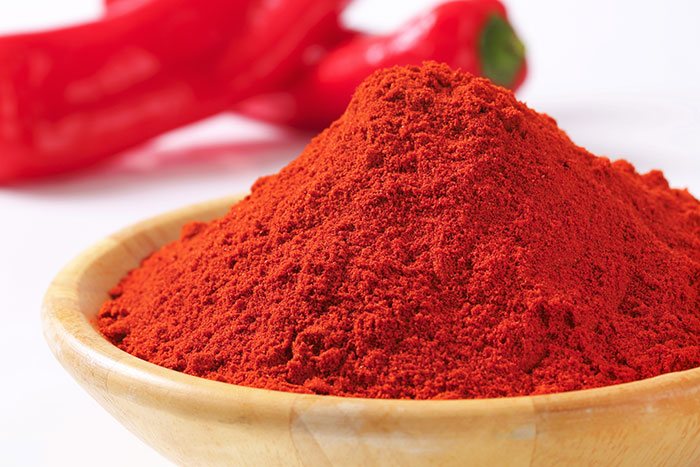البابريكا Paprika
Paprika is a spice made from dried, ground peppers, often derived from various types of sweet or hot peppers. This spice is bright red in color and ranges in flavor from hot to mild, depending on the type of pepper used. Paprika sometimes has a smoky flavor, especially when prepared with smoked peppers.
Type: Powder.
Types of paprika:
Sweet paprika: This is the most common type and is characterized by its mild, sweet flavor. It is primarily used in dishes that require a warm flavor without excessive heat.
Hot paprika: It has a moderate heat and adds a pungent flavor to dishes.
Smoked paprika: Made from peppers that are smoked before being dried, imparting a rich, smoky flavor that gives dishes a unique depth and character.
Benefits:
Although paprika is primarily used as a flavoring ingredient, it has many health benefits that make it a rich and beneficial component of the daily diet:
Rich in antioxidants
Paprika is a rich source of antioxidants, such as vitamin C and beta-carotene, which help combat free radicals that can cause cell damage and increase the risk of chronic diseases such as cancer and heart disease.
Promoting Eye Health
Because of its beta-carotene content, paprika can help improve eye health and reduce the risk of eye diseases such as macular degeneration and cataracts. Beta-carotene is converted in the body into vitamin A, which is essential for good vision.
Improves Digestion
Paprika contains compounds that enhance digestion and help alleviate digestive problems. Hot paprika can also stimulate the secretion of digestive juices, which contributes to improved digestion and relief from bloating.
Boosting immunity
Paprika is rich in vitamin C, one of the most important vitamins for boosting the immune system and helping fight infectious diseases such as colds and flu.
Reduces inflammation
Paprika contains anti-inflammatory compounds such as capsaicin, which helps reduce swelling and pain in the body. Capsaicin is known for its soothing and anti-inflammatory effects.
Improves blood circulation
The capsaicin found in paprika helps improve circulation and increase blood flow throughout the body, enhancing the flow of oxygen and nutrients to tissues and cells.
Uses:
Paprika isn’t just a spice that adds a delicious flavor to foods; it can also be used in many dishes to add a special touch. Here are some common uses for paprika:
In meat and poultry:
Paprika is commonly used in marinades for meat and poultry, such as grilled chicken or roast beef. Paprika can be mixed with other spices such as garlic and cumin to give dishes a distinctive flavor.
In soups and stews:
Paprika is a great addition to soups and stews, whether in Mediterranean or Indian cuisine. Paprika adds a warm flavor to foods and enhances the richness of the flavor.
In vegetarian dishes:
Paprika can be used in vegetarian dishes such as vegetable soups or cooked vegetable dishes. It adds a delicious flavor that makes vegetarian dishes more appealing.
As a food garnish:
Paprika can be sprinkled on dishes as a garnish, such as salads or rice, to add a touch of color and flavor.
In mayonnaise or sauces:
Paprika adds a distinctive flavor to sauces, including mayonnaise or tomato sauce. Adding paprika to sauces makes them richer and more fragrant.
Notes and warnings:
Moderate Use: While paprika is considered safe for cooking, it’s important to use it in moderation, especially hot varieties, to avoid gastrointestinal irritation.
Proper Storage: Paprika should be stored in a dry, dark place away from excessive heat to ensure it retains its flavor and nutritional benefits for as long as possible.
Export Details to All Parts of the World:
Container: 20-foot container.
Packaging: Cartons or bags.
Packaging and Handling: Automated.
Weight: 10 or 20 kg.
Origin: Egypt.

